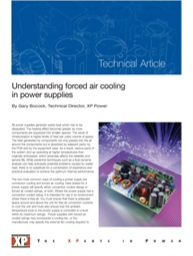Understanding forced air cooling in power supplies
All power supplies generate waste heat which has to be dissipated. The heating effect becomes greater as more components are squeezed into smaller spaces. The result of miniaturization is higher levels of heat per cubic volume of space.
The heat generated by components not only passes into the air around the components but is absorbed by adjacent parts, by the PCB and by the equipment case. As a result, various parts of the system end up operating at higher temperatures than originally anticipated, which adversely affects the reliability and service life.
Download this whitepaper to learn more.
Read More
By submitting this form you agree to XP Power contacting you with marketing-related emails or by telephone. You may unsubscribe at any time. XP Power web sites and communications are subject to their Privacy Notice.
By requesting this resource you agree to our terms of use. All data is protected by our Privacy Notice. If you have any further questions please email dataprotection@techpublishhub.com
Related Categories: Capacitors, Components, cooling, Power


More resources from XP Power

Custom power without custom pain
Despite the best intentions at the outset of an electronic product' s design, it's commonplace for the power supply specification to evolve during ...

Eliminating snubber circuits in AC/DC power supplies through the use of silicon carbide diodes
Silicon carbide diodes have been around for some time now but have had little take-up in power supplies due to their relatively high cost. XP Power...

Driving AC-DC power supply efficiency even higher
Reducing the size and improving the efficiency of AC-DC power supplies are constant pressures. In addition the requirement for portability in some ...
